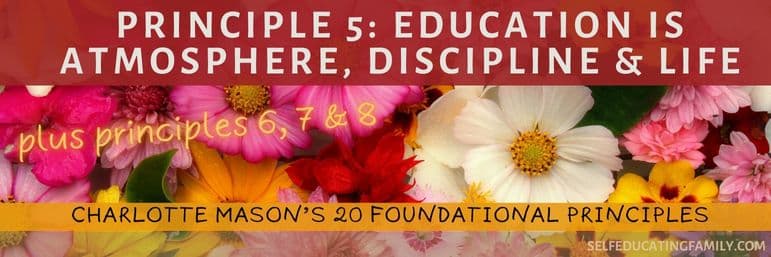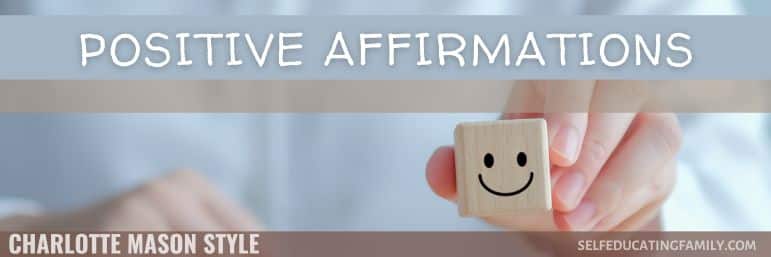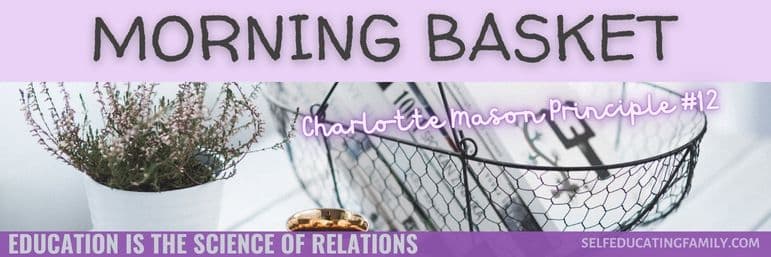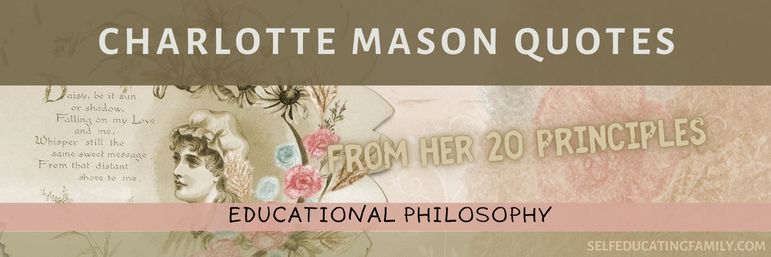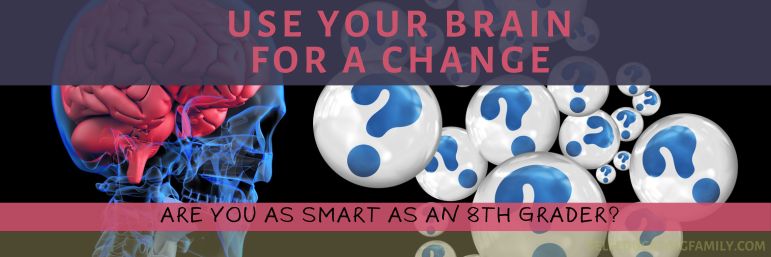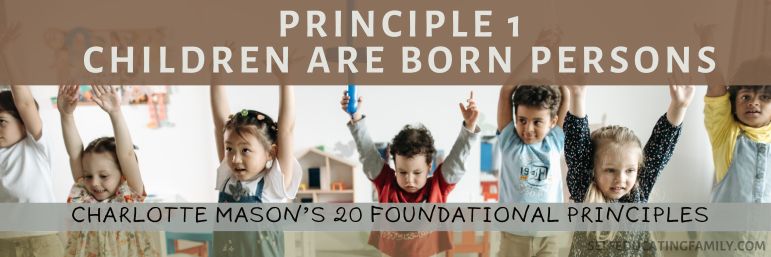What’s inside: Charlotte Mason’s quote “Education is an Atmosphere, a Discipline, & a Life” is principle # 5 in her 20 Principles towards an Educational Philosophy. Let’s take a closer look at this concept.
Education is an Atmosphere, a Discipline, & a Life
One of the most loved Charlotte Mason (CM) quotes among homeschoolers is “Education is an Atmosphere, a Discipline, & a Life”. This motto originated from the Parents’ National Educational Union (P.N.E.U.) for CM schools.
This is Principle 5 (and 6, 7, & 8!) in CM’s 20 Principles from Volume 6: Towards a Philosophy of Education.
This post may contain affiliate links. If you find my content valuable and make a purchase through one of my links, I will earn a commission at no cost to you, which helps me keep this blog going so I can help you even more! I recommend products I trust and/or use myself, and all opinions I express are my own. Read the full disclaimer here.
Background
We’ve been looking at each of Charlotte Mason’s “20 Principles” or “A Short Synopsis of the Educational Philosophy”. Earlier articles include:
- Charlotte Mason Principles
- Principle #1: Children are Born Persons
- Charlotte Mason Principle #3: Authority & Teachability
And so this post will look at Principle 5: Education is an Atmosphere, a Discipline, & a Life. In Book 1 of Volume 6, Charlotte Mason (CM) examines these three “instruments of education” — atmosphere, discipline, and life — in detail.
All Quotes are from Book 1 of Volume 6 Towards a Philosophy of Education, unless noted otherwise.
Why these Three Instruments?
CM builds on the concept in Principle 4:
These principles (ie., authority and docility from Principle #3) are limited by the respect due to the personality of children which may not be encroached upon whether by the direct use of fear or love, suggestion or influence, or by undue play upon any one natural desire.
Her conclusion is “THEREFORE we are limited to three educational instruments…”
In other words, BECAUSE we respect the differences in each child, we can only use an atmosphere of environment, a discipline of habit, and a presentation of living ideas in educating children. Because we respect the innate child, we don’t use things like coercion, bribery, “edjutainment”, or appeals to emotion to educate.
The only things left are these three instruments: environment, discipline, and life.
I didn’t get it at first
I think some of those other things work. Short term.
Like bribery. It was one of my favorite ways to motivate was to offer some kind of prize or bribe. “We’ll have snack time when this math worksheet is done!” (That was in my early days. P.S. Don’t use worksheets. Math manipulatives are much more appropriate for the younglings.)
It takes finesse to set up your day with natural consequences while educating multiple ages. Charlotte Mason is not against natural consequences – in the younger years especially, your children will need to learn self-will to apply themselves to their “work” in a timely fashion. And you need to help them. But to see a sibling move on to another subject (like snack, which I often think should be its own subject!) may help with self-motivation. The more appropriate response in the above situation with the bribe might be something like, “It seems like your mind is wandering. Maybe we should put away math for some Swedish drill for 5 minutes and then see if you can focus better.” (Quiet direction, using short lessons, and breaking up the materials can help increase the habit of attention.)
It’s a bit subtle. That’s okay if you don’t get it at first, just work with the ideas for a bit and see what happens.
My other favorite was entertaining the children. I think I was really good at making beautiful unit studies, but I’m not sure how much they got out of it while they were little because I was the one doing all the work.
Big Tip for the atmosphere
- Don’t make a “child” environment. It apparently “stultifies”.
stultify: stŭl′tə-fī″ transitive verb
- To cause to lose interest or feel dull and not alert.
- To render useless or ineffectual.
- To cause to appear stupid, inconsistent, or ridiculous.
I know, I know… What about the Montessori method of educating? I would argue that except for the “child-sized” tools and equipment, a Montessori environment can be full of rich, living ideas. It’s generally clean, orderly, beautiful, and rich with materials. The real difference or issue with Montessori would be that the teacher provides too much for the child. The atmosphere is one of a special area for child-learning or that you need a special area just for learning. And this is what would go against the CM principle of “education is an atmosphere”.
But Montessori is a discussion for another day.
Let’s look at the atmosphere in more detail.
Atmosphere
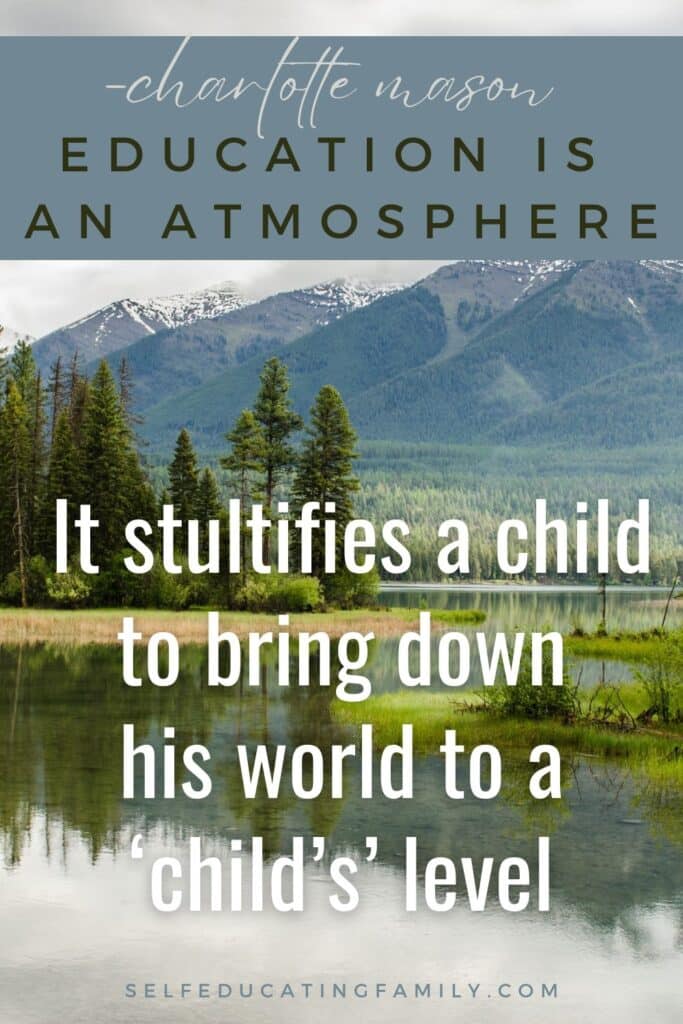
The bracing atmosphere of truth and sincerity should be perceived in every school.
pg. 97
CM emphasizes that the child is to live in his “natural environment”. It is not a specially created, pampered world where he never sees hardship or challenge, nor is it the opposite where he is treated like an adult with all the adult problems and decisions.
She likens the coddled atmosphere to a hothouse where you can grow plants, but if you just throw them out in the real air, the plant would be too weak to thrive. As for the other extreme, she reminds us that “due relations must be maintained” – you are the parent and they are the child. (Refer back to Principle 3: Authority & Docility.) You as the parent should not burden the child with that which isn’t in their orbit. It sounded like she had to deal with a lot of parents who were sharing too many of their wartime troubles with the children and the kids were having to deal with trying to protect their moms. But she doesn’t go into detail on that.
Remember, she was writing this last Volume AFTER WWI. England had just gone through some rough times. So she is a bit more reflective on some of these issues.
Read some of the passages regarding atmosphere:
The bracing atmosphere of truth and sincerity should be perceived in every School; and here again the common pursuit of knowledge by teacher and class comes to our aid and creates a current of fresh air perceptible even to the chance visitor, who sees the glow of intellectual life and moral health on the faces of teachers and children alike. …
pg 98
But a school may be working hard, not for love of knowledge, but for love of marks, our old enemy; and then young faces are not serene and joyous but eager, restless, apt to look anxious and worried. The children do not sleep well and are cross; are sullen or in tears if anything goes wrong, and are, generally, difficult to manage. …
We foresee happy days for children when all teachers know that no other exciting motive whatever is necessary to produce good work in each individual of however big a class than that love of knowledge which is natural to every child.
And this:
There are two courses open to us in this matter. One, to create by all manner of modified conditions a hot-house atmosphere, fragrant but emasculating, in which children grow apace but are feeble and dependent; the other to leave them open to all the “airts that blow,” but with care lest they be unduly battered; lest, for example, a miasma come their way in the shape of a vicious companion.
pg. 99
I get such a kick out of how she says things!
But you get the idea – find a balance in your “atmosphere”.
Education is a discipline
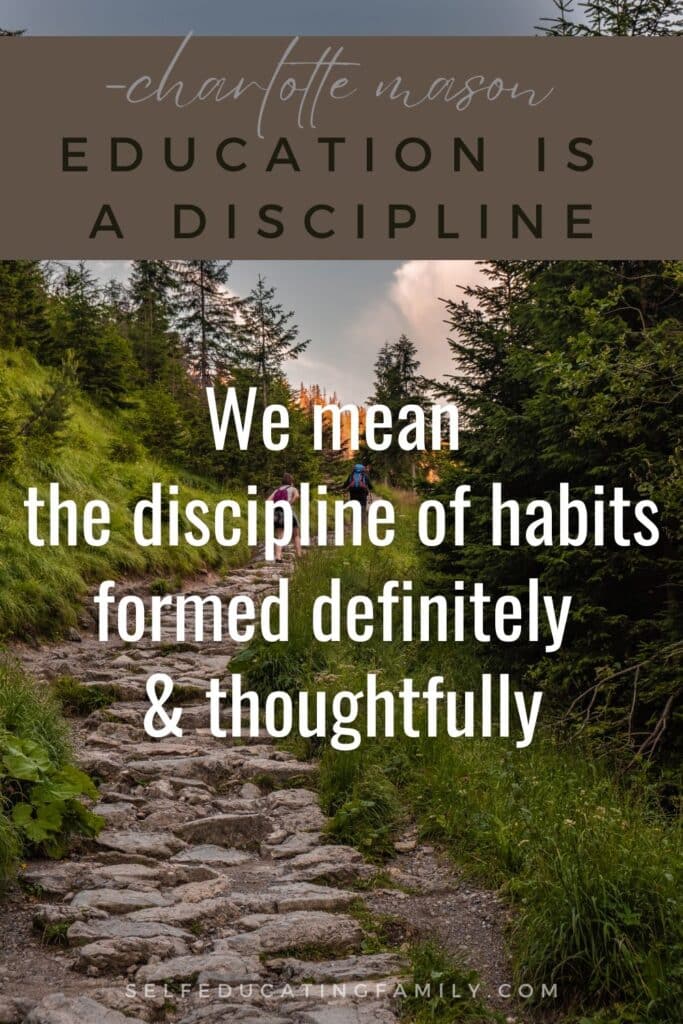
By this formula we mean the discipline of habits formed definitely and thoughtfully whether habits of mind or of body. Physiologists tell us of the adaptation of brain structure to habitual lines of thought, i.e., to our habits.
Did you know that educators were thinking of brain science more than a hundred years ago? Check out this quote:
Physiologists tell us that thoughts which have become habitual make somehow a mark upon the brain substance.
-pg 100
Today’s neuroscientists agree that you can change your brain in a number of ways, including habits.
But don’t go overboard: Charlotte Mason had much to say about habits, but she also said it wasn’t the be-all and end-all of an education.
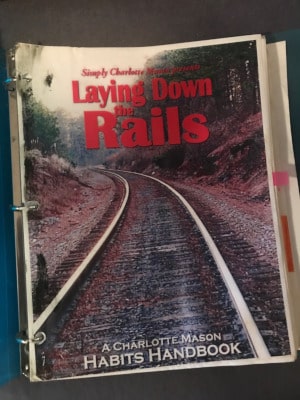
A good reference book on habits for young people that I highly recommend is called Laying Down the Rails by Sonya Shafer of Simply Charlotte Mason. The name comes right from CM’s chapter: “Both [soul and flesh] are at our service in laying down the rails, so to speak, upon which the good life must needs run.”
Another way to think about the “both” she refers to is “mind and spirit”. We used the Laying Down the Rails book as a guide when my boys were young and I highly recommend it.
CM is looking at the results of education.
Whether or no the mind be served by the brain in this matter [of habits], we are empirically certain that a chief function of education is the establishment of such ways of thinking in children as shall issue in good and useful living, clear thinking, æsthetic enjoyment, and, above all, in the religious life.
pg 100
Effort
But establishing these habits takes effort, but not the kind you might think of:
There is always effort to be made in certain directions; yet we face our tasks from a new point of view. We need not labour to get children to learn their lessons; that, if we would believe it, is a matter which nature takes care of. Let the lessons be of the right sort and children will learn them with delight. P 99
So the effort of habit formation is on the part of the child, where the domain of the parent/teacher is to provide the food for the brain, and guide along the way. The process is as follows:
- “The intellectual habits of the good life form themselves in the following out of the due curriculum in the right way.”
- “As we have already urged, there is but one right way, that is, children must do the work for themselves. They must read the given pages and tell what they have read, they must perform, that is, what we may call the act of knowing.”
- “[This] ‘act of knowing,’ as easy to a child as breathing and, if we would believe it, comparatively easy to ourselves.”
I’ve translated this into a graphic in case you find it challenging to read 1920s English!
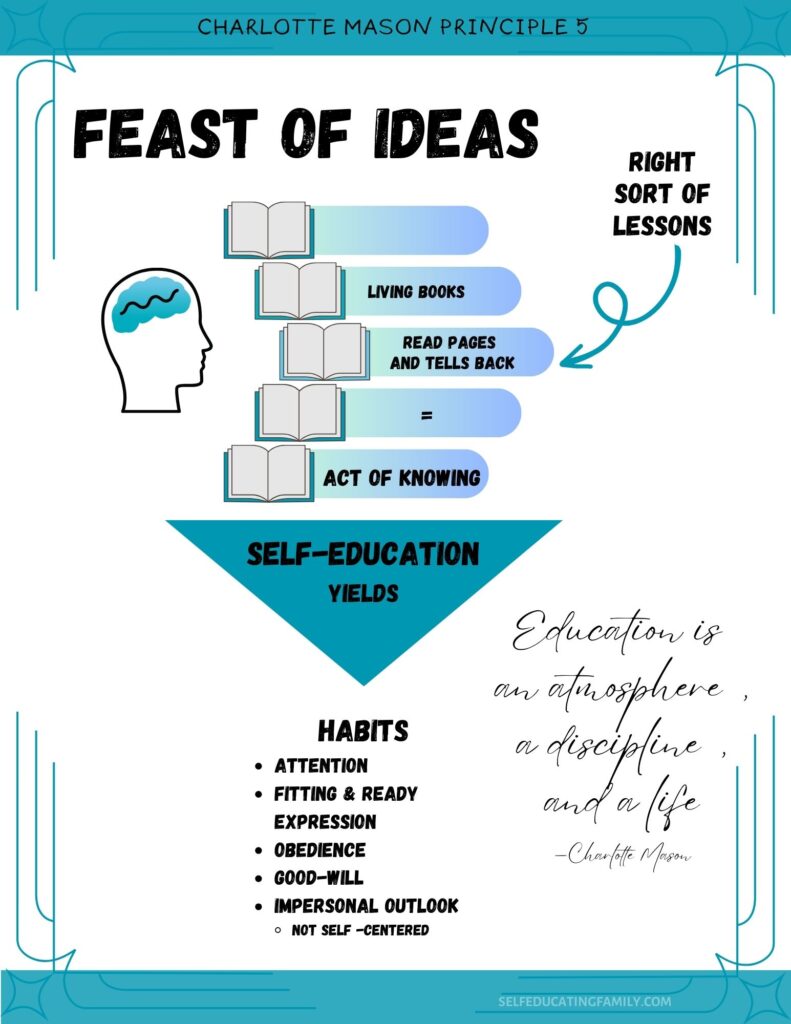
What kind of habits?
CM notes how the habits of self-education are acquired, and what some of them are:
No intellectual habit is so valuable as that of attention; it is a mere habit but it is also the hall-mark of an educated person.
pg 99
The habits of fitting and ready expression, of obedience, of good-will, and of an impersonal outlook are spontaneous bye-products of education in this sort. So, too, are the habits of right thinking and right judging; while physical habits of neatness and order [also] p100
Where the Parent comes in
Assisting the formation of habits of self-education is important, because either you form good habits or bad ones.
More, habit is inevitable.
-pg 101
Either you lay down “proper” rails, or you lay down bad habits. Either way, you are forming habits. And it does take effort.
There is no other way of forming any good habit, though the discipline is usually that of the internal government which the person exercises upon himself; but a certain strenuousness in the formation of good habits is necessary because every such habit is the result of conflict.
-pg 102
Habits and Discipline
To sum up this method, the parent (teacher) sets before the child a feast of information through living books. The “right sort of lesson”: the child reads the pages and “tells back” to show that the “act of knowing” has taken place in the child’s brain. (Note: Narration can take many forms of “telling back” including material demonstrations, as in the case of the final projects in Sloyd or in a musical recital.)
The outcome of such self-education discipline includes the habit of attention (most valuable) and others such as “fitting and ready expression” (the ability to communicate ideas), obedience, good-will, and “impersonal outlook” (not self-centeredness).
Quick pointers
Remember, the discussion comes from the book that CM wrote which focused on the older children. The younger children have had these methods also, but you (as the teacher) have had to gently remind or refocus each child as they learn to govern themselves through this process.
In other words, you just don’t throw some books at a kid and tell them to have at it without practicing it for the habits to become habitual. It’s like leaving a toothbrush out on the sink for a 2 year-old and never mentioning what to do with it.
But remember, what is necessary while helping establish a habit becomes unnecessary and even problematic later on when the child has matured in their habits.
Education is a Life
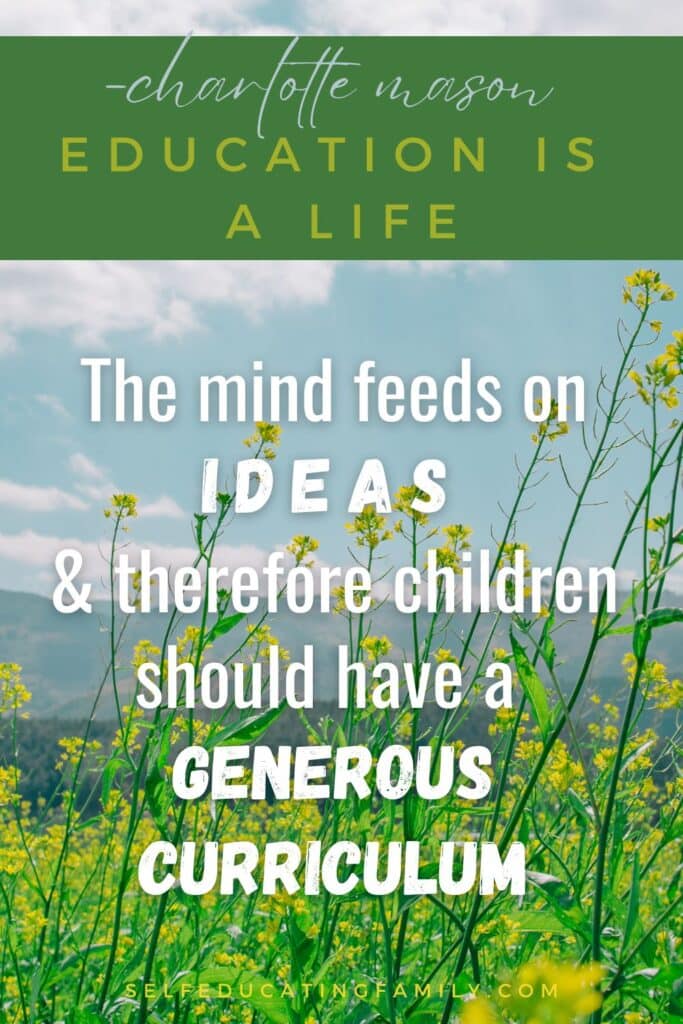
Possibly, the great discovery of the twentieth century will be that mind too requires its ordered rations and perishes when these fail.
-pg 104
What do you think? Did scientists discover that the mind needs mental sustenance in the past 100 years?
There’s definitely a lot of research on the literal food that you eat that supports brain health! But ideas?
While I think that this is a completely logical conclusion, I can’t seem to find exact research on it. Which would make sense because you are talking about what makes functioning citizenry, really.
There is a lot of research on the development of the child-brain and what it needs at various mental ages. But I think they are more concerned with how kids learn and develop. And yet, so many child experts believe that it is vitally important to read to your kids.
According to Christopher Austin & LoveReading.co.uk, “Psychologists from Washington University have conducted research using brain scan technology. Their studies show that every time you read something you build a mental picture in your head of what you have read.”
So that may be scientific proof that reading and telling back increases your brain capacity.
Anyway, back to what CM thought, who I think was ahead of her time.
The mind feeds on ideas
This is the key concept behind “Education is a life”.
That life is sustained on ideas.
– pg 109
Life-breathing ideas.
CM does make a distinction based on age, however.
In the early days of a child’s life it makes little apparent difference whether we educate with a notion of filling a receptacle, inscribing a tablet, moulding plastic matter, or nourishing a life, but as a child grows we shall perceive that only those ideas which have fed his life, are taken into his being; all the rest is cast away or is, like sawdust in the system, an impediment and an injury.
-pg 109
Parent/Teacher responsibilities
Making sure the child is fed belongs to the parent.
We must sustain a child’s inner life with ideas as we sustain his body with food. P 109
But it is OK if he picks and chooses what resonates with him. That goes back to Principle 1: Children are Born Persons.
Probably he will reject nine-tenths of the ideas we offer, as he makes use of only a small proportion of his bodily food, rejecting the rest. He is an eclectic; he may choose this or that; our business is to supply him with due abundance and variety and his to take what he needs.
-pg. 109
And remember, no forcing the issue!
Urgency on our part annoys him. He resists forcible feeding and loathes predigested food.
-pg 109
A funny aside
And remember also, forcing learning is not the same thing as “requiring” a subject – like math. I pick on math a lot because many people seem to struggle with it. My guys are great at math, but when I was using a curriculum that didn’t fit our needs, they rejected math. It was actually the concept of “subtraction” — one of my sons rejected the idea that any cookies would be subtracted from him. If he had 4 cookies and his brother had none, his answer to how to make it even and fair was to keep all the cookies himself.
We still required math, but I had to find a more appropriate match in how to teach it. Which was ironically the trigger for how I found CM methods.
A final caution
CM leaves us with this final caution to make sure we aren’t using abridged versions of great books or excerpts:
One other caution; it seems to be necessary to present ideas with a great deal of padding, as they reach us in a novel or poem or history book written with literary power. A child cannot in mind or body live upon tabloids however scientifically prepared; out of a whole big book he may not get more than half a dozen of those ideas upon which his spirit thrives; and they come in unexpected places and unrecognised forms, so that no grown person is capable of making such extracts from Scott or Dickens or Milton, as will certainly give him nourishment.
-pg. 110
Finally, she wraps up exactly what is a generous curriculum. It sums up “Education is an atmosphere, a discipline, and a life.”
All I have said is meant to enforce the fact that much and varied humane reading, as well as human thought expressed in the forms of art, is, not a luxury, a tit-bit, to be given to children now and then, but their very bread of life, which they must have in abundant portions and at regular periods. This and more is implied in the phrase, “The mind feeds on ideas and therefore children should have a generous curriculum.”
-pg 111
FAQ
To recap:
In Charlotte Mason’s words, “Education is an atmosphere” takes “into account the educational value of his natural home atmosphere, both as regards persons and things, and should let him live freely among his proper conditions. It stultifies a child to bring down his world to the child’s’ level.”
Charlotte Mason had 20 principles that she identified that detail her philosophy of education. These principles are found at the beginning of each of her 6 Volumes of The Home Education Series. You can grab a free PDF version of Charlotte Mason’s 20 Principles here.
The first principle in her philosophy of education is that “Children are born persons.” The rest build on that. “Education is an atmosphere, a discipline, and a life” covers principles #5, #6, #7, & #8.
Charlotte Mason’s educational philosophy embraces the child as a whole. The goal is to make a complete person as best they can be.
Related Articles

For further study
- Does the brain need food?
- (Literal) Food for the brain
- Brain Development in Children
- Child Development Theories
- Why it is Important to Read to Your Child
- Why reading books is vital for human development
- Brain & Reading Research
- Why reading is important for children

